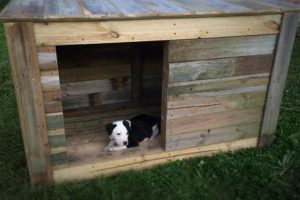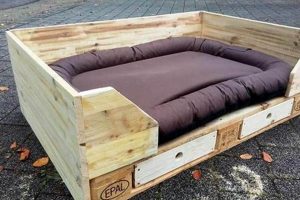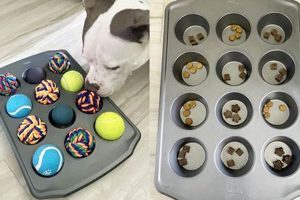A homemade canine exercise device, often constructed from readily available materials, offers an alternative to commercially manufactured equipment. This approach enables pet owners to create customized fitness solutions for their dogs, tailoring size and speed to individual needs. An example might include repurposing a human treadmill frame with modifications for safety and canine comfort, or building a manually operated walking platform.
Creating personalized exercise solutions for canines provides a cost-effective method for maintaining their physical well-being, particularly beneficial in adverse weather conditions or when outdoor activities are limited. Historically, specialized canine exercise equipment has been expensive, driving the adoption of do-it-yourself approaches to provide accessible and affordable fitness options. This approach fosters pet owner ingenuity and resourcefulness in addressing canine health needs.
The subsequent sections will delve into the essential considerations for design and construction, focusing on safety protocols, material selection, and appropriate training techniques for successful implementation of a custom-built canine exercise apparatus. Attention will be given to adapting existing equipment and building from scratch, offering a comprehensive overview of the process.
Essential Considerations for Homemade Canine Exercise Devices
Successful construction and implementation of a do-it-yourself canine exercise device requires meticulous planning and adherence to safety protocols. The following tips provide a framework for ensuring a beneficial and secure experience for the animal.
Tip 1: Prioritize Safety. The primary concern must be the animal’s well-being. Design features should eliminate pinch points, sharp edges, and unstable surfaces that could cause injury. Regular inspection and maintenance are essential to identify and rectify potential hazards.
Tip 2: Gradual Introduction is Crucial. The dog must be acclimatized to the apparatus slowly. Begin with brief, supervised sessions, rewarding positive behavior and gradually increasing the duration and intensity as the animal becomes more comfortable. Avoid forcing the dog to use the equipment.
Tip 3: Implement Speed Control Mechanisms. Whether manually operated or motorized, the speed must be precisely controlled to prevent overexertion and potential injury. A slow, consistent pace is more beneficial than bursts of high-intensity activity. Monitor the animal’s gait and adjust accordingly.
Tip 4: Material Selection Impacts Durability. Choose sturdy, non-toxic materials capable of withstanding repeated use and exposure to canine activity. Consider factors such as grip, ease of cleaning, and resistance to wear and tear. Replace worn or damaged components promptly.
Tip 5: Dimensions Must Accommodate the Breed. The length and width of the walking surface must be appropriate for the dog’s stride length and body size. Insufficient space can lead to improper gait and increased risk of injury. Adjustments may be necessary as the animal grows.
Tip 6: Regular Monitoring is Required. Observe the animal closely for signs of fatigue, discomfort, or stress during use. Take frequent breaks and provide access to water. Discontinue use immediately if any adverse reactions are noted and consult with a veterinarian if concerns arise.
Tip 7: Training Should Be Consistent. Utilize positive reinforcement techniques to encourage proper use and maintain the dog’s motivation. Establish a clear routine and provide consistent cues. Consult with a professional dog trainer for guidance on appropriate training methods.
Adhering to these guidelines ensures the homemade canine exercise device contributes positively to the animal’s health and fitness while minimizing the risk of injury or distress.
The final section will provide insights on adapting existing treadmills and building a platform from scratch.
1. Safety mechanisms integration.
The construction of a “diy dog treadmill” necessitates a fundamental emphasis on safety mechanisms integration. This is not merely an add-on feature, but rather a core design principle influencing the overall functionality and mitigating potential risks inherent in a moving mechanical device used by an animal. The absence of appropriate safety features transforms a potentially beneficial exercise tool into a hazardous undertaking. Cause and effect are directly linked: inadequate safety integration leads to an elevated risk of injury, while comprehensive integration reduces this risk considerably. For example, a “diy dog treadmill” lacking an emergency stop mechanism presents a significant hazard. Should the dog panic or become entangled, the treadmill’s continued operation could result in severe harm. Similarly, the omission of side rails increases the likelihood of the dog falling off the apparatus, particularly at higher speeds.
The practical significance of understanding and implementing safety mechanisms lies in the ability to create a secure environment for canine exercise. Consider the incorporation of a low-speed setting specifically designed for initial acclimation. This allows the dog to gradually adapt to the motion of the treadmill without experiencing overwhelming fear or anxiety. Another practical application involves the use of non-slip surfaces to provide secure footing and prevent accidental slips or falls. Furthermore, an easily accessible shut-off switch, positioned for immediate activation by the owner, ensures prompt intervention in the event of an emergency. Real-life examples abound of commercially available dog treadmills that prioritize safety features, demonstrating their critical role in product design. Mimicking these design considerations in a homemade version is imperative.
In summary, the successful implementation of a “diy dog treadmill” is intrinsically linked to the comprehensive integration of safety mechanisms. These features are not discretionary; they are essential components that directly impact the animal’s well-being and the overall effectiveness of the device. While challenges may arise in sourcing appropriate materials or replicating complex commercial designs, prioritizing safety remains paramount. Failure to do so negates the potential benefits of the homemade exercise device, potentially resulting in more harm than good.
2. Adequate surface dimensions.
Surface dimensions represent a critical determinant in the safe and effective utilization of a self-constructed canine exercise apparatus. The relationship between these dimensions and the animal’s physical attributes dictates the usability and potential benefits of the device.
- Stride Length Accommodation
Insufficient length necessitates a compressed or unnatural gait, leading to premature fatigue and potential musculoskeletal strain. Conversely, excessive length may intimidate the animal or encourage an unsafe increase in speed. The walking surface must accommodate the dog’s natural stride at its intended exercise pace. Real-world examples involve observations of dogs exhibiting an altered gait on treadmills with surfaces too short for their breed, thereby highlighting the importance of accurate measurement and planning during construction.
- Width and Balance
Inadequate width compromises the animal’s balance and increases the risk of accidental falls, particularly for breeds with broader stances. The walking surface must provide sufficient lateral space to accommodate the dog’s typical movement patterns without restricting natural shifts in weight and posture. Instances of dogs exhibiting hesitation or lateral instability on narrow treadmill surfaces underscore the need for appropriate width consideration during the planning phase of a “diy dog treadmill” project.
- Breed-Specific Considerations
Dimensions must align with specific breed characteristics. A Great Dane requires significantly larger surface area than a Dachshund. Failure to account for breed-specific physical attributes renders the exercise device unsuitable, and potentially harmful, to the animal’s physical well-being. Consideration of breed-specific ergonomic needs is integral to a successful “diy dog treadmill” project. It is important to consult breed standards to understand optimal surface measurements.
- Growth Considerations
For younger animals, growth must be factored into the dimensional planning. A treadmill suitable for a puppy may quickly become inadequate as the animal matures. Constructing an adjustable surface area or planning for future expansion mitigates the need for complete replacement as the dog grows. Neglecting this factor introduces the potential for increased construction costs over time and necessitates vigilant monitoring of the animal’s fit on the treadmill during its growth phases.
These dimensional considerations are central to the ethical and practical construction of any “diy dog treadmill”. Appropriate dimensions directly contribute to safety, comfort, and efficacy. Failure to adequately address these aspects undermines the potential benefits of the homemade exercise apparatus.
3. Controlled speed regulation.
The integration of precise speed control is a non-negotiable aspect of any “diy dog treadmill” design. Without such regulation, the potential for injury and ineffective exercise protocols increases exponentially. The implementation of adjustable and consistent speed settings directly impacts the safety, efficacy, and overall benefit derived from the device.
- Injury Prevention via Incremental Progression
Sudden or uncontrolled increases in speed can lead to muscle strains, joint injuries, or even panic in the animal. Controlled regulation enables gradual increases in speed, allowing the dog to acclimatize to the motion and maintain a proper gait. Professional canine rehabilitation treadmills incorporate precisely calibrated speed controls as a standard feature, demonstrating the importance of this principle in minimizing injury risk. Attempting to bypass controlled progression by implementing a fixed, potentially excessive speed, is highly irresponsible.
- Customization for Individual Canine Needs
Different breeds, ages, and physical conditions necessitate varied exercise intensities. A small, senior dog requires a significantly slower pace than a young, energetic Labrador. Controlled speed regulation facilitates the tailoring of exercise regimens to meet the specific needs of each individual animal. Commercial canine treadmills offer a range of pre-programmed settings designed to accommodate diverse canine profiles, underlining the value of customizable speed parameters.
- Maintenance of Consistent Exercise Intensity
Fluctuations in speed can disrupt the animal’s rhythm and diminish the effectiveness of the exercise session. Consistent speed regulation ensures a steady state of exertion, promoting cardiovascular health and muscle development. High-quality motorized treadmills utilize feedback mechanisms to maintain a constant speed irrespective of minor variations in the animal’s weight distribution or gait. Emulating this consistency, even through manual adjustments, is crucial for achieving optimal exercise outcomes.
- Facilitation of Rehabilitation Protocols
For dogs recovering from injuries or surgeries, precise speed control is essential for targeted rehabilitation exercises. Slow, controlled movements can help rebuild muscle strength and improve range of motion without placing undue stress on the affected areas. Veterinary physical therapists routinely employ adjustable treadmills to facilitate controlled weight-bearing exercises in post-operative canine patients. This reinforces the importance of fine-grained speed adjustments in promoting healing and recovery.
These considerations underscore the crucial role of controlled speed regulation in the successful and responsible construction of a “diy dog treadmill”. Failure to prioritize this aspect significantly compromises the safety and efficacy of the device. While achieving the precision of a commercial unit may present challenges, incorporating mechanisms for incremental and consistent speed control is an essential investment in the animal’s well-being.
4. Durable material selection.
The durability of materials employed in the construction of a “diy dog treadmill” is a primary factor influencing the lifespan, safety, and overall utility of the device. Appropriate selection mitigates risks associated with wear and tear, structural failure, and potential harm to the animal during operation.
- Frame Integrity and Stability
The structural framework of the device must withstand the repetitive stress and dynamic loading exerted by the animal’s weight and movement. Materials such as reinforced steel, high-density polyethylene (HDPE), or treated hardwoods offer superior load-bearing capacity and resistance to deformation compared to less robust alternatives. Commercial treadmills often employ welded steel frames, demonstrating the industry standard for structural integrity. Selection of substandard framing materials invites premature failure and compromises the safety of the animal.
- Walking Surface Resilience
The walking surface should exhibit resistance to abrasion, tearing, and slippage. Materials such as textured rubber, durable canvas belting, or specialized anti-slip coatings provide the necessary traction and wear resistance to withstand repeated use. Smooth or easily damaged surfaces increase the risk of falls and injuries. Industrial conveyor belts, designed for demanding applications, serve as a benchmark for evaluating the resilience of potential walking surface materials. Selecting materials specifically designed for grip and durability is key to preventing injury.
- Resistance to Environmental Factors
Materials exposed to moisture, temperature fluctuations, or direct sunlight must exhibit resistance to degradation. Untreated wood is susceptible to rot, while certain plastics may become brittle or warp under prolonged exposure to ultraviolet radiation. Using weather-resistant materials, such as pressure-treated lumber or UV-stabilized polymers, extends the lifespan of the device and minimizes the need for frequent repairs or replacements. Outdoor dog runs frequently utilize these durable materials, offering a real-world illustration of their effectiveness. The environment the treadmill is in is a important factor when select the materials.
- Non-Toxic Composition
All materials used in the “diy dog treadmill” must be non-toxic and safe for canine contact. Certain paints, coatings, or adhesives may contain harmful chemicals that can be ingested or absorbed through the skin. Selecting materials certified as pet-safe or using natural, non-toxic alternatives minimizes the risk of allergic reactions or health complications. Manufacturers of pet toys and accessories adhere to stringent safety standards regarding material composition, providing a relevant point of reference for material selection. The animals health is always top priority.
The long-term performance and safety of a “diy dog treadmill” depend heavily on the judicious selection of durable and appropriate materials. While cost considerations may influence material choices, prioritizing longevity and animal safety over initial expense is crucial. Investing in high-quality materials ensures a reliable and safe exercise device for the canine companion, ultimately proving more economical in the long run by reducing the need for frequent repairs or replacements.
5. Gradual introduction protocol.
The gradual introduction protocol is not merely a suggestion, but a fundamental prerequisite for the safe and effective utilization of a homemade canine exercise apparatus. Its adherence directly mitigates the risks associated with sudden exposure to novel stimuli and promotes the animal’s acclimation to the “diy dog treadmill.”
- Mitigation of Neophobia and Anxiety
Canines, by nature, exhibit varying degrees of neophobia, the fear of new things. An abrupt introduction to a “diy dog treadmill,” with its unfamiliar sights, sounds, and tactile sensations, can trigger significant anxiety. A gradual protocol, involving incremental exposure and positive reinforcement, allows the animal to adapt at its own pace, reducing stress and fostering a sense of security. Animal behaviorists frequently employ desensitization techniques based on gradual exposure when introducing animals to potentially stressful environments. Failing to heed this protocol can result in long-term aversion to the device.
- Prevention of Musculoskeletal Strain
Unaccustomed to the repetitive motion of a treadmill, a canine’s musculoskeletal system requires time to adapt. A gradual introduction allows for the progressive strengthening of muscles and ligaments, minimizing the risk of strains, sprains, or other injuries. Athletic trainers implement progressive overload principles in human athletes to prevent injury; the same rationale applies to canine conditioning. Sudden, prolonged exercise on a “diy dog treadmill” without adequate preparation is akin to expecting an untrained individual to run a marathon without prior training.
- Establishment of Positive Associations
The introduction process offers a crucial opportunity to establish positive associations with the “diy dog treadmill.” Utilizing positive reinforcement techniques, such as rewarding the animal with treats or praise for approaching, sniffing, or stepping onto the device, creates a favorable mental connection. Conversely, forcing or coercing the animal onto the treadmill can generate negative associations, leading to resistance and potentially behavioral problems. Professional dog trainers routinely emphasize the importance of positive reinforcement in shaping desired behaviors. By establishing a positive association, training and use become less stressful.
- Gait Assessment and Adjustment
The gradual introduction period allows for careful observation and adjustment of the animal’s gait on the “diy dog treadmill.” Subtle deviations from a natural stride may indicate underlying musculoskeletal issues or improper surface dimensions. Early identification of these issues allows for timely correction, preventing the development of compensatory movements that could lead to further injury. Veterinarians frequently assess gait as part of routine physical examinations, underscoring the importance of identifying and addressing any abnormalities. These gait issues can be addressed prior to prolonged sessions.
The multifaceted benefits of a gradual introduction protocol cannot be overstated in the context of a “diy dog treadmill.” Beyond preventing immediate physical harm, it promotes a positive and sustainable relationship with the device, maximizing its potential as a valuable tool for canine fitness and well-being. Implementing a well-structured gradual introduction protocol will benefit the owner and the animal.
6. Consistent training routines.
Consistent training routines are crucial for the successful and safe integration of a do-it-yourself canine exercise device into a dog’s life. These routines facilitate acclimation, promote proper usage, and reinforce positive associations with the treadmill.
- Habitual Exposure and Reinforcement
Regular, scheduled training sessions establish the device as a predictable element in the dog’s environment. This predictability reduces anxiety and fosters a sense of comfort. Employing consistent positive reinforcement, such as treats or praise, during these sessions further solidifies the positive association. The absence of a routine leads to inconsistent engagement, hindering the dog’s adaptation and potentially fostering negative perceptions. For example, dedicating 15 minutes each day at the same time for treadmill training, coupled with rewards, promotes a more favorable response than sporadic, unscheduled attempts.
- Progressive Skill Development and Conditioning
Consistent training allows for the gradual progression of skills, from initial introduction to independent operation. Each session builds upon previous successes, reinforcing correct behaviors and incrementally increasing duration and intensity. This methodical approach minimizes the risk of overexertion or injury. A structured routine facilitates tracking progress and adjusting training parameters as needed. Consider a training regimen starting with simply approaching the device, followed by stepping onto it, and gradually increasing walking time. This progression relies on consistent repetition and reinforcement.
- Behavioral Modification and Problem-Solving
Consistent training provides opportunities to identify and address any behavioral issues that may arise during treadmill use. Regular observation allows for early detection of signs of stress, anxiety, or discomfort. Addressing these issues proactively through counter-conditioning or desensitization techniques prevents the development of negative habits. For instance, if a dog exhibits fear of the treadmill’s motor, consistent exposure to the sound at a low volume, paired with rewards, can help alleviate the anxiety. The identification of this fear requires consistent training sessions.
- Maintenance of Physical and Mental Stimulation
Beyond the initial training phase, consistent use of the “diy dog treadmill” as part of a regular exercise routine provides ongoing physical and mental stimulation. This routine helps maintain the dog’s physical fitness, prevents boredom, and reduces the likelihood of destructive behaviors. Integrating treadmill sessions into a daily schedule alongside other activities, such as walks or playtime, ensures a well-rounded and stimulating environment for the animal. Consistency prevents the animal from regressing in its comfort and ability to use the device.
The implementation of consistent training routines is essential for maximizing the benefits and minimizing the risks associated with a “diy dog treadmill”. These routines promote acclimation, facilitate skill development, address behavioral issues, and provide ongoing physical and mental stimulation, thereby contributing to the overall well-being of the canine companion.
7. Regular equipment maintenance.
Regular equipment maintenance is an indispensable element of the successful integration and long-term functionality of a “diy dog treadmill.” The inherent nature of homemade devices necessitates vigilance in monitoring structural integrity and operational safety. Neglecting routine maintenance directly increases the risk of mechanical failure, potential injury to the animal, and diminished efficacy of the exercise regimen. Consider, for instance, the gradual loosening of bolts or screws in the treadmill frame. Without periodic inspection and tightening, this seemingly minor issue could escalate to structural instability, potentially resulting in a collapse during use. Similarly, fraying of the walking surface material, if left unaddressed, could lead to entanglement and subsequent injury to the animal’s paws. Therefore, consistent maintenance serves as a proactive measure, mitigating risks and ensuring the continued safe operation of the equipment.
The practical significance of regular maintenance extends beyond immediate safety concerns. It directly impacts the lifespan and overall cost-effectiveness of the “diy dog treadmill.” Addressing minor issues promptly prevents them from developing into more significant problems requiring costly repairs or even complete replacement of the device. For example, lubricating moving parts on a regular basis reduces friction and wear, extending the life of bearings and other critical components. Similarly, cleaning the walking surface to remove debris and prevent the build-up of dirt or hair maintains optimal traction, reducing the risk of slippage and potential injury. Real-world examples abound of commercially manufactured treadmills requiring scheduled maintenance to uphold warranty provisions and ensure optimal performance, underlining the universality of this principle. Replicating this proactive approach with a homemade device is essential.
In summary, regular equipment maintenance is not an optional consideration, but a critical component of responsible ownership and utilization of a “diy dog treadmill.” It ensures the safety and well-being of the canine companion, extends the lifespan of the device, and ultimately proves more economical in the long run. While challenges may arise in sourcing specific replacement parts or replicating professional maintenance procedures, the fundamental principle of proactive inspection and timely repair remains paramount. Failure to prioritize maintenance negates the potential benefits of the homemade exercise device and introduces unacceptable levels of risk.
Frequently Asked Questions
The following section addresses common inquiries and misconceptions regarding the construction and utilization of a homemade canine exercise apparatus. The information provided aims to offer clarity and informed guidance to individuals considering this undertaking.
Question 1: What are the primary safety concerns associated with a DIY dog treadmill?
Safety concerns encompass pinch points, exposed moving parts, inadequate surface grip, and the absence of emergency stop mechanisms. Proper design and construction must prioritize mitigation of these hazards to prevent injury to the animal. Regular inspection and maintenance are critical.
Question 2: How crucial are appropriate dimensions for the walking surface?
Dimensions are paramount. The length must accommodate the dog’s natural stride length at its intended exercise pace, preventing unnatural gait or strain. Width must provide sufficient lateral space for balance and stability. Breed-specific considerations are essential.
Question 3: What is the recommended approach for introducing a dog to a homemade treadmill?
A gradual introduction protocol is essential. This involves incremental exposure to the device, coupled with positive reinforcement. This approach mitigates anxiety and fosters a positive association, preventing aversion and resistance.
Question 4: How important is controlled speed regulation?
Controlled speed regulation is critical. It facilitates gradual progression, customization for individual canine needs, and maintenance of consistent exercise intensity. Sudden or uncontrolled speed increases pose a significant risk of injury.
Question 5: What materials are best suited for constructing a durable dog treadmill?
Durability hinges on appropriate material selection. The frame requires robust materials like reinforced steel or treated hardwoods. The walking surface demands resistance to abrasion and slippage, utilizing textured rubber or durable canvas belting. Non-toxic composition is paramount.
Question 6: How frequently should a homemade dog treadmill be inspected and maintained?
Regular inspection and maintenance are crucial. Components should be inspected before each use. Lubrication of moving parts should occur on a monthly basis. Promptly address any signs of wear, damage, or instability to ensure continued safe operation.
The construction and utilization of a DIY dog treadmill require careful planning, diligent execution, and unwavering attention to safety. By addressing the aforementioned concerns and adhering to recommended practices, individuals can create a valuable tool for canine fitness and well-being.
The subsequent section explores specific considerations for adapting existing treadmills and building a platform from scratch.
Conclusion
The preceding analysis has delineated essential considerations for the creation and implementation of a “diy dog treadmill.” Topics addressed range from safety protocols and material selection to the necessity of controlled speed regulation and consistent training. These elements, when meticulously addressed, contribute to the creation of a functional and secure exercise device for canines.
The construction of a “diy dog treadmill” demands a rigorous commitment to safety and an informed understanding of canine physiology. This undertaking requires careful assessment and adherence to established best practices. The ultimate success of this project rests upon the owner’s dedication to responsible and ethical practices, ensuring the animal’s well-being takes precedence over all other considerations.







